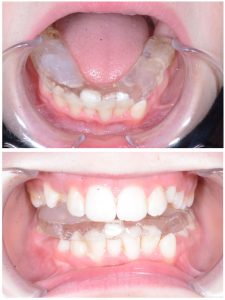Treatment
Treatment goals for JIA-associated TMJ arthritis are to prevent progression of condylar damage and dentofacial deformity; decrease orofacial symptoms, such as pain; and prevent progression or reverse orofacial dysfunction.
Management of TMJ arthritis should be led by a multidisciplinary team, including but not limited to a pediatric rheumatologist, physiotherapist, orthodontist, oral maxillofacial surgeon, radiologist and dental specialist. The team’s composition depends on location and the patient’s healthcare system.
Treatment can roughly be divided into four different categories: 1) reducing TMJ inflammation (i.e., systemic and intra-articular treatment); 2) controlling signs and symptoms via oral splints, physiotherapy, adjustment to systemic treatment or arthrocentesis; 3) normalizing mandibular growth (via oral splints); and 4) surgical correction of TMJ/dentofacial deformity in skeletally mature patients.

These clinical photographs depict an acrylic distraction splint worn full time. Every six to eight weeks, a thin layer of acrylic is added to the right sight of the splint to distract this side of the face and normalize mandibular growth and development.
Disease-modifying anti-rheumatic drugs (DMARDs) and biologics are also used for the treatment of JIA-associated TMJ arthritis. The exact effect of these treatments remains unanswered in studies with TMJ MRIs pre- and post-treatment. However, empirical practice suggests these treatments are as effective for the TMJ as for other peripheral joints. Earlier initiation of treatment is believed to give better outcomes than treatment late in the TMJ arthritis course. A recent Swiss study showed improvement of the TMJs on systemic treatment.8
Intra-articular corticosteroid injections (IACs) were routinely used for TMJ arthritis, as for other peripheral joints in JIA. However, studies have shown a reduced growth of the mandible after TMJ IACs in animals, and these findings have been supported by retrospective human data, suggesting that treatment of TMJ arthritis with IACs can lead to reduced mandibular growth.9,10 The current recommendation is not to use IACS for the management of TMJ arthritis—and certainly not repeated IACs—in skeletally immature JIA patients. Intra-articular heterotopic bone formations have also been associated with IACs, especially if use is recurrent throughout the disease course.
IACs can be used to treat TMJ arthritis in skeletally mature individuals.
Orthopedic devices, such as oral splints, have proved effective for the treatment of orofacial symptoms associated with TMJ arthritis and in the reduction of dentofacial deformities from TMJ arthritis in growing individuals.11,12 Orthopedic devices are routinely used in Scandinavian countries for the treatment of JIA-associated TMJ involvement; however, such devices may be difficult to obtain in other healthcare systems in other countries due to their cost. Orthodontic treatment of JIA-associated dentofacial deformity requires special training, and availability of this treatment is, for now, limited.


